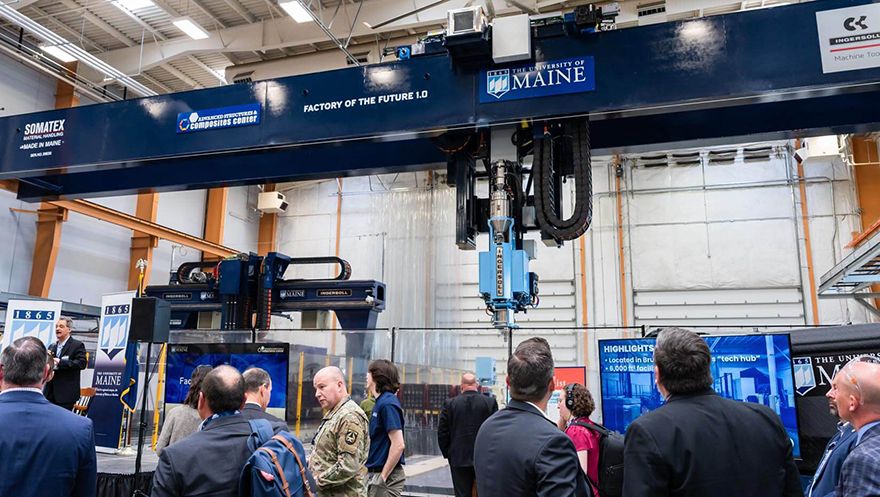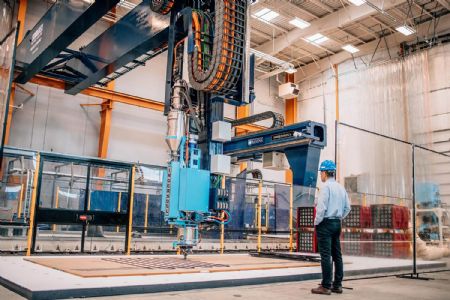
Surpassing its own 2019
Guinness World Record for the largest polymer 3-D printer,
UMaine (University of Maine) recently unveiled a next-generation printer that is four-times larger than its predecessor to ‘catalyse the future of sustainable manufacturing in a number of industries’.
The new 3-D printer, dubbed Factory of the Future 1.0 (FoF 1.0), was unveiled on 23 April at the Advanced Structures and Composites Center (ASCC) to an audience that included representatives from the US Department of Defense, US Department of Energy, the Maine State Housing Authority, industry partners and other stakeholders who plan to use this technology. The thermoplastic polymer printer is designed to print objects as large as 96ft long x 32ft wide x 18ft high, and can print up to 500 pounds/per hr.
It offers new opportunities for eco-friendly and cost-effective manufacturing for numerous industries, including national security, affordable housing, bridge construction, ocean and wind energy technologies and maritime vessel fabrication. The design and fabrication of this world-first 3-D printer and hybrid manufacturing system was made possible with support from the Office of the Secretary of Defense through the US Army Corps of Engineers.
FoF 1.0 is not merely a large-scale printer; it dynamically switches between various processes such as large-scale additive manufacturing, subtractive manufacturing, continuous tape layup and robotic arm operations. Access to it and MasterPrint, the ASCC’s first world-record breaking 3-D printer, will streamline manufacturing innovation research at the centre. The two large 3-D printers can collaborate by sharing the same end-effectors or by working on the same part.
Important milestoneUS Senator Susan Collins said: “UMaine and the Advanced Structures and Composites Center possess the innovation, capacity, and workforce to support the future needs of the Department of Defense in advanced manufacturing. I congratulate President Joan Ferrini-Mundy and Dr Habib Dagher on another important milestone and look forward to witnessing the Center’s continued innovation that is invaluable to our national security.”
Since fiscal year 2022, Senator Collins, vice chair of the Senate Appropriations Committee and Sub Committee on Defense, has secured more than $93 million in support of this initiative and other defence projects at the ASCC.
 Pictured right: a large 3-D printer
Pictured right: a large 3-D printerASCC executive director Habib Dagher said: “FoF 1.0 opens up new research frontiers to integrate these collaborative robotics operations at a very large scale with new sensors, high-performance computing and artificial intelligence to create born-certified systems that meet high-quality standards. We are grateful for Senator Collins’ support, for support from Maine’s congressional delegation and for collaborations with the Department of Defense, Department of Energy, Oak Ridge National Labs, Maine Housing and our industry partners here in Maine and beyond.”
The one-of-a-kind 3-D printer will advance various initiatives, including the development of bio-based feedstocks from wood residuals abundant in Maine. This technology will advance commercialisation efforts such as BioHome3D and the creation of sustainable, affordable housing, while also propelling crucial technological advancements for national security, particularly in lightweight rapidly deployable structures and vessel technologies.
Heidi Shyu, undersecretary of defense for research and engineering (OUSD (R&E)) and chief technology officer for the Department of Defense, said: “The Department of Defense has been advancing composites and manufacturing technologies with the University of Maine ASCC for nearly two decades. The latest innovations in manufacturing, composite technologies and materials coming from our universities have and will continue to be instrumental to the security and economic vitality of the US and its allies and partners worldwide.”
University of Maine System Chancellor Dannel Malloy said: “I want to congratulate the University of Maine on achieving yet another major research and development milestone and thank our state, federal, industry and philanthropic partners for their steadfast support that makes this progress for Maine possible. With this massive new 3-D printer and the soon-to-be-built Green Engineering and Materials Factory of the Future, Maine’s R1 university will further its global leadership in advanced manufacturing and materials science, ensure our flagship is a destination for education and research at the intersection of engineering and computing, and accelerate solutions that strengthen the state’s economy and communities.”
UMaine president Joan Ferrini-Mundy said: “This new capability not only reinforces UMaine’s Carnegie R1 research designation, but also reaffirms our standing as leaders in composite materials research and advanced manufacturing. With the participation of different departments, faculty, students and university partners, today stands as a testament to the university’s commitment to collaborative excellence. It not only empowers us to nurture the leaders of tomorrow, but also ignites growth and prosperity within Maine’s local industries and across the national stage.”
 Pictured left: undersecretary of defense for research and engineering (OUSD (R&E)) and chief technology officer for the Department of Defense Heidi Shyu and UMaine president Joan Ferrini-Mundy
Pictured left: undersecretary of defense for research and engineering (OUSD (R&E)) and chief technology officer for the Department of Defense Heidi Shyu and UMaine president Joan Ferrini-MundyThe FoF 1.0 unveiling comes ahead of this summer’s planned groundbreaking of a new 47,000ft
2 research laboratory called the Green Engineering and Materials (GEM) Factory of the Future. Scheduled for an August groundbreaking, the facility is positioned to enhance manufacturing innovation across multiple sectors. Its primary aim is to facilitate and scale up more sustainable manufacturing practices by introducing next-generation solutions and biomaterials, addressing challenges such as a diminishing workforce and strained supply chains with local solutions.
MaineHousing’s development director Mark Wiesendanger said: “Maine needs an estimated 80,000 additional homes by 2030, many specifically for households with incomes at or below the area median income. This new technology allows UMaine-ASCC to scale-up its research and production of its innovative biobased 3-D printed home technology. This effort creates another means of producing quality affordable housing, while further driving costs down, and using abundant wood residuals from Maine’s sawmills. We look forward to continuing our collaboration with Dr Dagher, the staff and students at UMaine/ASCC in demonstrating how 3-D printed homes and other next-generation housing technologies will quickly and efficiently contribute to enhancing Maine’s housing stock.”
The research facility will not only scale-up advanced manufacturing processes, but also explore innovative materials systems by prioritising recycled and biobased materials. Maine, the most forested state in the nation, annually produces more than one-million tonnes of wood residuals in its sawmills, which can be used as feedstock for 3-D printing. In addition, UMaine, with the GEM initiative, has prioritised manufacturing workforce development by offering experiential learning and entrepreneurial training programmes aimed at nurturing the next generation of leaders.
In tandem with research and development, the GEM Factory of the Future aligns with the formation of the Maine College of Engineering and Computing (MCEC), a statewide initiative funded by the Harold Alfond Foundation as part of UMS Transforms that prioritises developing a workforce prepared for the increasingly interconnected and digital global economy.
Giovanna Guidoboni, inaugural dean of MCEC, said: “The Maine College of Engineering and Computing is proud to be a strong partner in developing the Factory of the Future 1.0. This partnership brings together engineering and material technologies together with advanced computing, creating unprecedented hands-on learning experiences in advanced manufacturing for our students and providing venues to develop new classes, electronic credentials and new majors.”